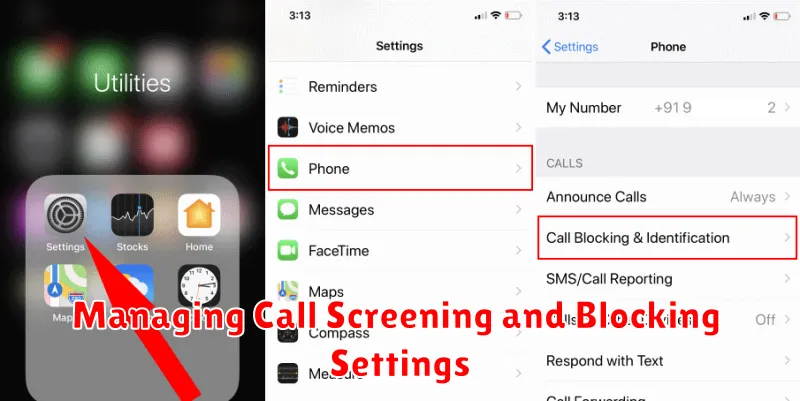Tired of incessant spam calls and messages disrupting your day on your Android phone? You’re not alone. Millions of Android users are bombarded with unwanted communications, from robocalls peddling dubious products to phishing text messages attempting to steal personal information. Reclaiming your peace and taking control of your digital life is possible. This article provides effective strategies to help you block spam calls and messages effectively on your Android device, allowing you to finally silence the unwanted noise.
Whether you’re dealing with persistent telemarketers, annoying robocalls, or potentially dangerous spam messages, this guide offers practical solutions to regain control over your Android phone. Learn how to identify and block spam calls, filter unwanted messages, and utilize built-in Android features and third-party apps designed to combat this pervasive issue. Explore the various strategies to block spam messages and protect yourself from potential scams. This article empowers you to create a more peaceful and secure mobile experience.
Understanding the Different Types of Spam Calls and Messages
Before diving into blocking methods, it’s crucial to understand the various types of spam you might encounter. This understanding will help you choose the most effective blocking strategies.
Robocalls: These are automated calls that often deliver pre-recorded messages. They can range from legitimate telemarketing to outright scams.
Spam Texts: Similar to robocalls, these unwanted text messages can advertise products, attempt phishing scams, or contain malicious links.
Spoofed Calls: These calls deliberately falsify the caller ID to appear as a local or familiar number, tricking you into answering.
Vishing (Voice Phishing): These calls attempt to trick you into revealing sensitive personal information, such as bank details or social security numbers, often by impersonating a legitimate organization.
Smishing (SMS Phishing): This type of spam uses text messages to lure you into clicking malicious links or providing personal information.
Utilizing Built-in Android Features to Block Spam
Your Android phone offers several built-in features to combat spam calls and messages without needing third-party apps. These tools provide a first line of defense against unwanted communications.
Most Android phones allow you to directly block numbers from your recent calls list. Simply tap and hold the offending number, then select “Block/report spam.” This instantly prevents further calls or texts from that specific number.
Within the Phone app’s settings, you’ll likely find a “Blocked numbers” section. Here, you can manually add numbers to your blocklist, offering more granular control. Some devices also offer an option to block calls from unknown or hidden numbers, which can significantly reduce spam calls, but be mindful as it might also block legitimate calls from unrecognized contacts.
The “Caller ID & spam” feature is another essential tool. Enabling this option helps identify potential spam calls and provides warnings during incoming calls. It relies on Google’s database to flag suspected spammers, offering an extra layer of protection.
Exploring Third-Party Spam Blocking Apps and Services

While built-in Android features offer a baseline defense, third-party apps provide advanced capabilities to combat spam more effectively. These apps often leverage larger, crowd-sourced databases of known spam numbers, offering more comprehensive protection.
Many reputable spam blocking apps are available on the Google Play Store. They typically offer features like automatic spam identification and blocking, caller ID identification for unknown numbers, and customizable blocklists. Some apps even offer reverse phone lookup functionality to help identify unknown callers.
When selecting a third-party app, consider factors such as the app’s reputation, user reviews, and the features offered. Be mindful of privacy policies regarding data collection and usage. Some apps operate on a subscription basis, so factor in any associated costs.
Popular choices include apps specializing in call blocking, as well as broader security suites that incorporate spam blocking as part of their feature set. Researching and comparing options will help you find the best fit for your needs.
Identifying and Reporting Spam Numbers to Your Carrier
Reporting spam numbers to your carrier helps them track and potentially block these numbers for other users. It contributes to a larger effort to combat spam and improve the overall network experience.
Most carriers provide a straightforward method for reporting spam. You can usually forward the spam message itself to a designated shortcode provided by your carrier. For spam calls, note down the number and either call or message your carrier’s customer service line to report it. Check your carrier’s website for specific instructions, as the process can vary.
Identifying a spam number is often intuitive. Calls from unknown numbers with spoofed caller IDs, repeated calls from the same number despite being ignored, or messages containing suspicious links or requests are all potential indicators of spam.
By actively reporting spam, you contribute to a safer communication environment for yourself and others.
Creating Custom Filters and Blocklists
For more granular control over unwanted communications, Android allows you to create custom filters and blocklists. This feature empowers you to proactively block calls and messages based on specific criteria.
Call filtering often allows you to block numbers with specific prefixes or area codes. This can be useful for avoiding international spam or calls from known problematic regions. Some Android versions also allow blocking calls from numbers not in your contacts.
Blocklists, on the other hand, let you manually add specific numbers. If you consistently receive spam from a particular number, adding it to your blocklist prevents future contact. You can typically access and manage your blocklist through your phone app’s settings.
The specifics of implementing these features may vary slightly depending on your Android version and phone manufacturer. Consult your device’s user manual or support resources for detailed instructions.
Managing Call Screening and Blocking Settings

Your Android phone offers built-in features to manage unwanted calls and messages. Accessing these settings allows you to customize how your device handles potential spam.
Begin by opening your phone app. Typically, you’ll find a menu option (often represented by three vertical dots or similar icon). Within this menu, locate “Settings” or “Call settings.” Call blocking and identification settings are usually found within this section.
Within these settings, you can activate Caller ID & Spam. This feature helps identify potential spam calls. You can also enable the option to Filter spam calls, which will prevent many spam calls from ringing your phone.
Explore the Blocked numbers setting. Here, you can manually add specific numbers to a block list. This is particularly helpful for persistent spammers who bypass other filters.
Consider activating Silence unknown callers. This option will send calls from numbers not in your contacts directly to voicemail. This can be a powerful tool, but remember to check your voicemail periodically for legitimate calls.
Advanced Techniques for Blocking Persistent Spammers
For those truly persistent spammers, basic blocking might not be enough. Here are some advanced strategies to consider:
Third-Party Blocking Apps
Explore reputable third-party apps designed specifically for call and message blocking. These apps often maintain extensive databases of known spam numbers and use advanced algorithms to identify and filter out potential spam.
Reporting Spam Numbers
Actively report spam numbers to your carrier and relevant authorities. This helps build databases of known spammers, benefiting you and others. Many third-party apps offer built-in reporting features.
Utilizing “Do Not Disturb” Mode Strategically
Configure your phone’s “Do Not Disturb” mode to only allow calls and messages from contacts saved in your address book. This creates a strong barrier against unknown numbers, but remember to periodically review your contact list to ensure important calls aren’t accidentally blocked.
Protecting Yourself from Phishing and Smishing Attacks
Phishing and smishing attacks aim to steal your personal information through deceptive calls and messages. Staying vigilant is your first line of defense. Never click on links from unknown senders, as these could lead to malicious websites designed to capture your login credentials or download malware.
Verify the source. If a message appears to be from a legitimate organization, contact the organization directly through their official website or phone number to confirm the message’s authenticity. Don’t rely on the contact information provided in the suspicious message.
Be wary of urgent requests. Phishing and smishing attempts often create a sense of urgency to pressure you into acting quickly without thinking. Take your time to evaluate the message and look for red flags like unusual formatting, grammatical errors, or requests for sensitive information.
Report suspicious messages to your carrier and the appropriate authorities. This helps track spam and phishing trends and can prevent others from becoming victims.
Staying Informed About the Latest Spam Trends
Staying ahead of spammers requires vigilance and awareness of evolving tactics. Knowledge is power when it comes to protecting yourself.
Regularly consult reputable sources for information on current spam trends. This includes websites of consumer protection agencies, cybersecurity firms, and even your wireless carrier. These organizations often publish articles, alerts, and reports detailing new spam campaigns, common tactics, and preventative measures.
Pay attention to news reports regarding large-scale phishing or smishing attacks. Understanding how these scams operate can help you identify and avoid them. Be aware of trends in spoofed numbers or common themes used in spam messages.
By staying informed about the latest spam trends, you empower yourself to recognize and thwart spammers before they can disrupt your peace.

